Barriers on cycle paths

Access to routes that are open to cyclists, whether in urban or rural locations, are a growing issue for those who ride adapted cycles.
There are a number of ways that access can be compromised and often a range of users are affected; those riding adapted cycles, those with pushchairs, wheelchairs or mobility scooters, for example.
While there are issues for cyclists riding two wheelers, these issues are wider still for those riding bikes which have been adapted for practical purposes, e.g. to accommodate a disability, to carry a load or a second person.
In urban areas, despite some challenges presented by poorly surfaced routes, accessibility can also be challenged by the width available and by features such as cycle barriers forcing a cyclist to slow down, dismount or to choose an alternative route - if there is one.
In rural areas, many paths are not accessible owing to natural features. Where these routes have been designed for wider accessibility, manmade obstacles, such as barriers, often add to the challenges of those wishing to access them. While some barriers may be negotiated on a two wheeler by a cyclist with excellent control skills, others can render a potentially accessible route completely inaccessible.
Reasons given for the use of barriers on cycle paths often include:
- The need to exclude motorbikes or to prevent illegal access by other users.
- The need to control livestock in rural areas.
- The desire to slow speed on the approach to a junction.
Although guidance on Cycle Infrastructure Design was produced by the DfT in 2008, the inclusion of cycle barriers at the design stage is often the default position, and does not always take into account the range of users or the actual need for the measure in a particular location. The precise design solution, it could be argued, is not always 'fit for purpose' and it would be preferable to fit barriers at a later date, once usage has been established and monitored.
There are a number of solutions which could be considered where a need for access control has been established, or where speed calming would be desirable. These include:
- The use of surface treatment to indicate a change in speed is needed.
- Signage or other indications as to the accessibility of a particular route could be made available in advance and on the route.
- Bollards placed carefully and wide enough apart may be enough .
- A frame and K frame barriers may be used, although they will not give access to all adapted cycles.
- Where horse styles or other inaccessible barriers are used, an alternative should be available.
- While gates are not ideal, if well designed and maintained they may be made more accessible where needed.
If you would like further information about issues of accessibility, you may wish to visit:

